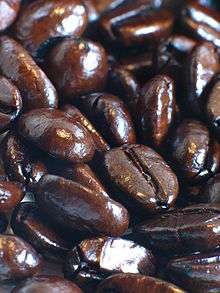Torrefacto
Torrefacto refers to a particular process of roasting coffee beans, common in Spain, France, Paraguay, Portugal, Mexico, Costa Rica, Uruguay and Argentina. The process involves adding a certain amount of sugar during roasting in order to glaze the beans. The glazed beans are then mixed with normal roasted beans. While originally a cheap way of preserving the coffee beans in the 1920s, a suggested reason for continued use of the technique has been maintenance of the aroma and taste of the coffee.

The addition of sugar during the torrefacto roasting process increases the production of compounds with antioxidant properties. Both ground and brewed torrefacto coffee has higher antioxidant capacity than standard roasts. In addition, the espresso method of extraction yielded higher antioxidant activity than other brewing methods.[1]
According to Sagi Cohen, the Torrefacto process allows coffee to be kept fresh for longer; lowers its price, as it is mixed with much cheaper sugar; and imparts it with flavors which he variously describes as "burnt sugar", "diluted asphalt" and "liquefied coal".[2]
See also

References
- López-Galilea I, Andueza S, di Leonardo I, Paz de Peña M, Cid C. Influence of torrefacto roast on antioxidant and pro-oxidant activity of coffee. Food Chemistry, 94;(1):75-80.
- כהן, שגיא (2019-06-20). "זאת בירה אירופית גדולה, אז למה לקפה יש טעם של בנזין?". Haaretz. Retrieved 2019-07-11.